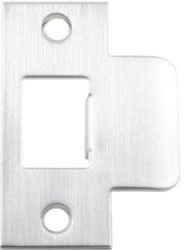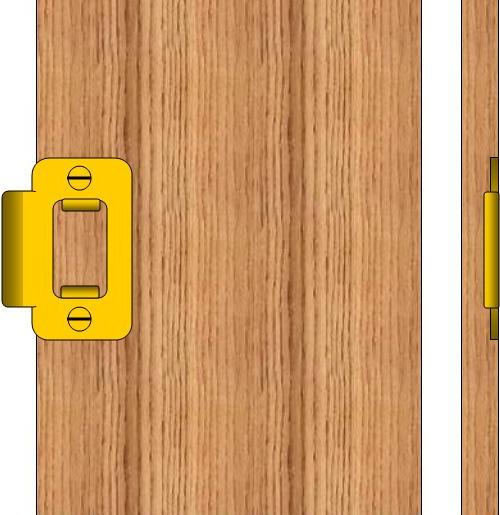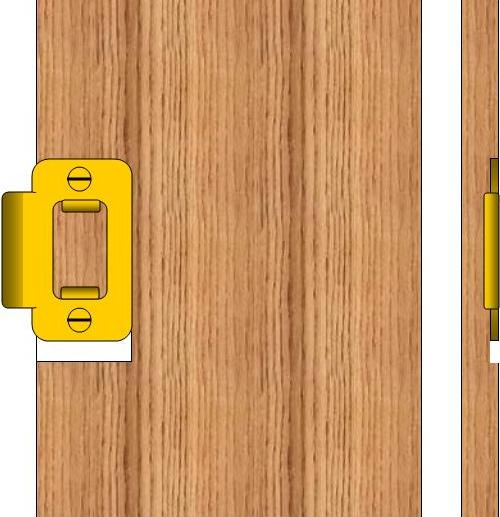The strike plate, as shown in Figure 1, is that piece of hardware that is mounted on the door jamb. The strike plate catches the door bolt, which is part of the passage set, and holds the door in a closed position.

Figure 1 - Door strike plate
The shifting and setting of a house or other building can cause an interior or exterior door to go out of alignment and in some cases it means that the door bolt will no longer seat properly in the strike plate, hence the door will not remain in the closed position.
Note: Before attempting to repair a misaligned strike plate make sure that the problem is not loose hinge screws or a damaged hinge. It is also likely that the door is sticking, as well as the strike plate being out of position.
In most cases the strike plate has been mortised into the door jamb in order for it to sit flat with the face of the door jamb. This means that adjusting the strike plate will most likely leave a visible gap between the door jamb and the strike plate.

Figure 2 - Strike plate on door jamb
Note: You will come across websites and books that suggest that you hit the strike plate with a chisel or other heavy object to drive its position either up or down. This proposed method of repair will generally cause more damage than it fixes. The screws holding the strike plate in position are not meant to move up or down, even a 1/16 inch. As well if the mortise is snug around the strike plate, which it should be, driving the strike plate up or down can cause the wood to split. If you want to have loose screws in the strike plate and/or split wood above or below the strike plate then follow their instructions.
Realigning a strike plate is not a simplistic project, if you want to do it properly. You will require a sharp wood chisel.

Figure 3 - Center of strike plate

Figure 4 - Center of door bolt
The first step is to determine the position that you want the strike plate, relative to where it is now. Does it need to go up or down and by how much? To do this, use a pencil to mark the center of the strike plate, as shown in Figure 3, and the center of the bolt. Close the door so that the door bolt is resting up against the strike plate and measure the distance that the center of the door bolt is off from the center of the door bolt, as shown in Figure 4. In our example the strike plate needs to be moved 1/4 inch up in order for the center of the strike plate to align with the center of the door bolt.
Step 2 is to measure 1/4 inch up from the current position of the strike plate and draw a straight line across the top and a line going down to match the inside edge of the strike plate, as shown in Figure 3.
Using a sharp wood chisel, preferably 1 inch or larger, remove the material between the lines and the old position of the strike plate.
Note: In our example the strike plate has rounded edges. Put the strike plate in its new position and trace the rounded corner in its proper position. Then, you will have to use a small chisel or if you are comfortable with a router use it to take out the excess material.
Place the strike plate in its new position and determine:
- If you will have to drill a new large hole for the door bolt in the center of the strike plate?
- If you will have to fill in the old large hole where the door bolt lodged after the door was closed in order to be able to insert the strike plate lower mounting screw?
- Once you have drilled the new holes for the door bolt and wood screws you can install the strike plate.
- You will now have the strike plate in the correct position but will also have a gap between the bottom of the strike plate and the face of the strike plate as shown in Figure 5. The gap should be filled with the two part epoxy wood fill and then painted.
Note: If you have to fill in the old large door bolt hole the best way to do it is with two part epoxy wood fill and a piece of dowel that fills the hole as best possible. If you are using a two part epoxy wood fill then fill the old strike plate screw holes at the same time. Allow the epoxy to dry thoroughly before drilling any new holes, this usually means at least 24 hours.

Figure 5 - Wood gap below strike plate
Note: If you have a natural wood finish or stained wood finish on the door jamb where you can see the wood grain, it is almost impossible to do a repair that is not noticeable. The exception being that a furniture refinisher can make those types of invisible repairs, however it may be difficult to justify the expense.
